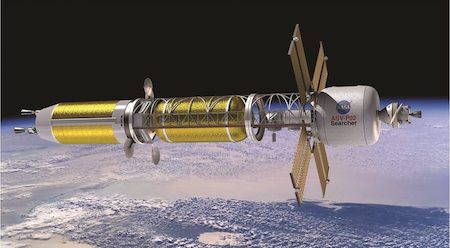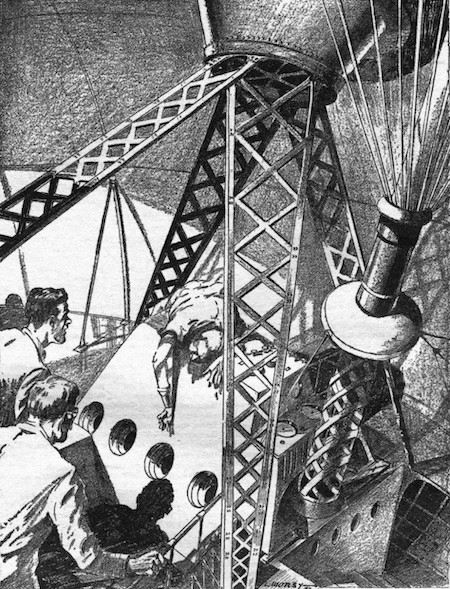Science Fiction
Dictionary
A B C D E F G H I J K L M N O P Q R S T U V W X Y Z
Mars Mission Using Nuclear Thermal Propulsion

Should we develop space nuclear propulsion technology to reach destinations in the solar system more quickly than low-energy Hohmann transfer orbits?

(Mars mission concept enabled by nuclear thermal propulsion)
It is naive and against national interests for the U.S. to rely on expensive, outdated, slow, single-use chemically propelled rockets like SLS to transport astronauts to Mars. Instead, America must aggressively invest in developing space nuclear propulsion systems.Nuclear technology, including nuclear electric propulsion (or “NEP”) and nuclear thermal propulsion (or “NTP”), will be a space travel game-changer with profound implications for deep space mission speed, agility and capability.
The increased propulsive power of nuclear systems will allow humans to head to Mars on a more regular cadence than the current mission launch windows of “every 26 months.” Nuclear propulsion also will allow power for astronauts on Mars missions to abort and return to Earth in the event of an emergency.
Obviously, science fiction writers are down with this program. I guess I think most strongly of that moment in Heinlein's 1961 novel Stranger in a Strange Land when he describes the crossing to Mars taking place in just nineteen days under Lyle Drive:
The Federation Ship Champion, manned by an all-male crew of eighteen experienced spacemen and carrying more than that number of male pioneers, made the crossing under Lyle Drive in only nineteen days. The Champion landed just south of Lacus Soli, as Captain van Tromp intended to search for the Envoy.
Even earlier, Eando Binder describes a similar journey to Mars in his 1932 short story The First Martian:
(The First Martian by Eando Binder)The inconceivable distance to be traversed, the enormous energy required to transport a heavy machine from planet to planet, and the all-powerful force of gravity, seemed insurmountable objects to even the most broadminded and optimistic thinkers. Feeble attempts were made even in 1931 to leave this speck of the universe and soar to other worlds, but constant failures dulled the ardor of those who wished to connect our world with the others which acknowledge the same central sun...
Although the fatalities far exceeded these probable successes, the hope of interplanetary travel was still uppermost in our minds. We know now, that our failure can be attributed to the unfortunate lack of radioactive elements, and not to the lack of ingenuity or inventiveness.
It was only too true. as Professor Billings stated in 1945, that the only type of engine which could possibly transport a heavy machine from our earth to some planet, would have to be the atomic-energy engine, which, with a minimum of fuel and the very necessary radioactive element, could develop an unlimited amount of energy.
He even drew plans of the basic principles of such an engine, estimated the amount of radioactive material needed, and worked out the propulsion of the ship.
As far as I know, the first reference to an "atomic engine" can be found in HG Wells' 1914 short story The World Set Free - but not in a space craft:
...the swift aëroplane, with its atomic engine as noiseless as a dancing sunbeam... flew like an arrow to the heart of the central European hosts.
Scroll down for more stories in the same category. (Story submitted 12/27/2022)
Follow this kind of news @Technovelgy.| Email | RSS | Blog It | Stumble | del.icio.us | Digg | Reddit |
Would
you like to contribute a story tip?
It's easy:
Get the URL of the story, and the related sf author, and add
it here.
Comment/Join discussion ( 0 )
Related News Stories - (" Space Tech ")
Will Space Stations Have Large Interior Spaces Again?
'They filed clumsily into the battleroom, like children in a swimming pool for the first time, clinging to the handholds along the side.' - Orson Scott Card, 1985.
Reflect Orbital Offers 'Sunlight on Demand' And Light Pollution
'I don't have to tell you about the seven two-mile-diameter orbital mirrors...'
Chrysalis Generation Ship to Alpha Centauri
'This was their world, their planet —
this swift-traveling, yet seemingly moveless vessel.' - Nat Schachner, 1934
The First Space Warship For Space Force
'Each of the electrical ships carried about twenty men...' - Garrett P. Serviss, 1898.
Technovelgy (that's tech-novel-gee!) is devoted to the creative science inventions and ideas of sf authors. Look for the Invention Category that interests you, the Glossary, the Invention Timeline, or see what's New.
Science Fiction
Timeline
1600-1899
1900-1939
1940's 1950's
1960's 1970's
1980's 1990's
2000's 2010's
Current News
Leader-Follower Autonomous Vehicle Technology
'Jason had been guiding the caravan of cars as usual...'
Golf Ball Test Robot Wears Them Out
"The robot solemnly hit a ball against the wall, picked it up and teed it, hit it again, over and again...'
Boring Company Vegas Loop Like Asimov Said
'There was a wall ahead... It was riddled with holes that were the mouths of tunnels.'
Rigid Metallic Clothing From Science Fiction To You
'...support the interior human structure against Jupiter’s pull.'
Is The Seattle Ultrasonics C-200 A Heinlein Vibroblade?
'It ain't a vibroblade. It's steel. Messy.'
Roborock Saros Z70 Is A Robot Vacuum With An Arm
'Anything larger than a BB shot it picked up and placed in a tray...'
A Beautiful Visualization Of Compact Food
'The German chemists have discovered how to supply the needed elements in compact, undiluted form...'
Bone-Building Drug Evenity Approved
'Compounds devised by the biochemists for the rapid building of bone...'
Secret Kill Switch Found In Yutong Buses
'The car faltered as the external command came to brake...'
Inmotion Electric Unicycle In Combat
'It is about the size and shape of a kitchen stool, gyro-stabilized...'
Grok Scores Best In Psychological Tests
'Try to find out how he ticks...'
PaXini Supersensitive Robot Fingers
'My fingers are not that sensitive...'
Congress Considers Automatic Emergency Braking, One Hundred Years Too Late
'The greatest problem of all was the elimination of the human element of braking together with its inevitable time lag.'
The Desert Ship Sailed In Imagination
'Across the ancient sea floor a dozen tall, blue-sailed Martian sand ships floated, like blue smoke.'
The Zapata Air Scooter Would Be Great In A Science Fiction Story
'Betty's slapdash style.'
Thermostabilized Wet Meat Product (NASA Prototype)
There are no orbiting Michelin stars. Yet.

